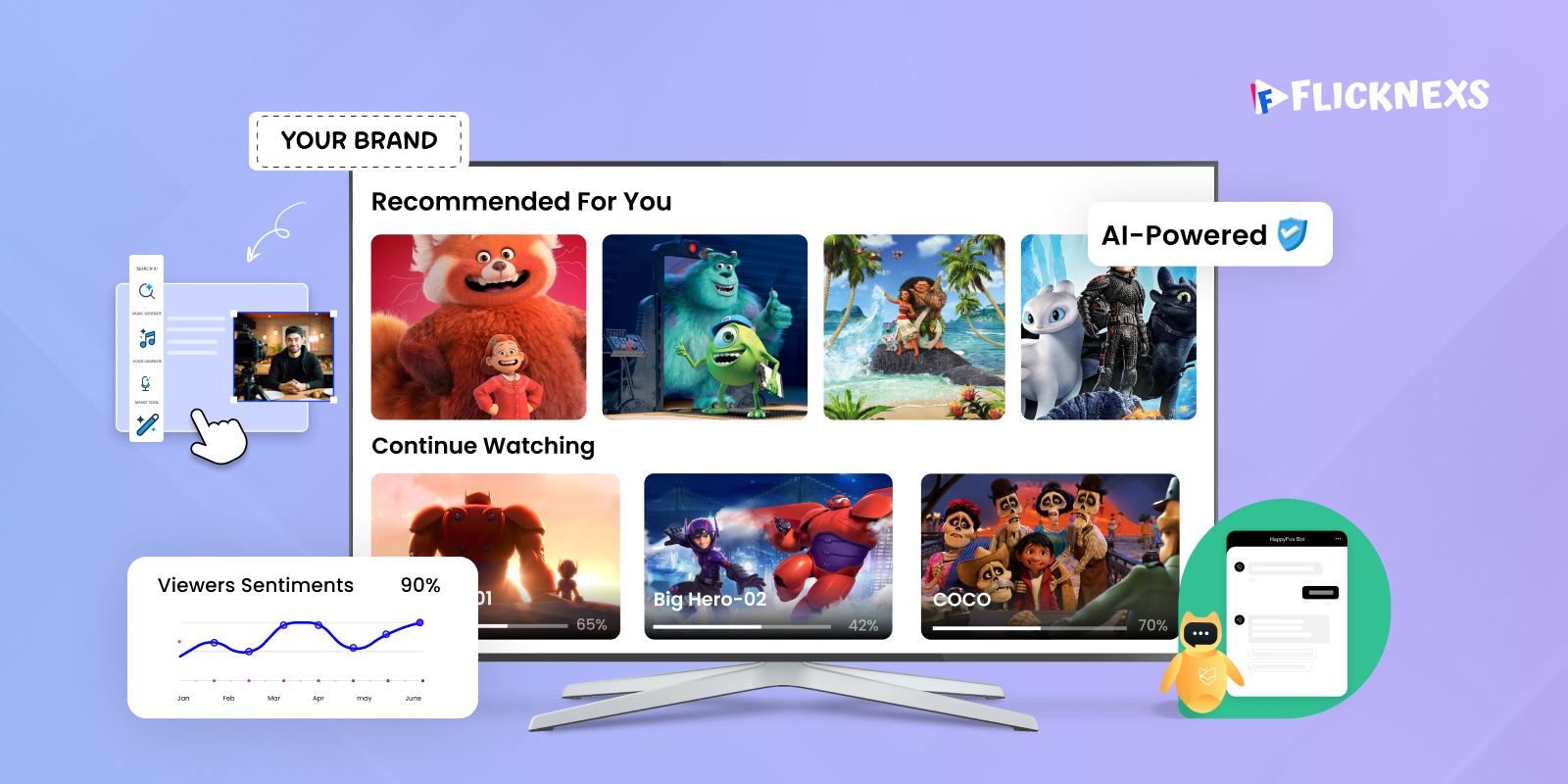2025 is shaping up to be the turning point for AI in OTT platforms. Streaming services are no longer just about delivering video—they’re about delivering experiences. AI-driven technologies are enabling platforms to offer hyper-personalized recommendations, optimize content strategies, boost revenue, and improve engagement like never before.
From global giants like Netflix and Prime Video to emerging startups, AI has become the secret ingredient for success in the OTT industry. Machine learning, predictive analytics, and intelligent automation are helping platforms understand their audience on a deeper level, anticipate user preferences, and deliver content that keeps viewers coming back.
By the end of this guide, you’ll know exactly how to implement AI in your OTT strategy for 2025—and why adopting AI is now a necessity, not an option.
Why AI Matters for OTT in 2025
The Growing Demand for Personalized Content
Viewers today expect content that matches their tastes, mood, and even time of day. AI-driven recommendation engines analyze viewing patterns, search history, and watch-time trends to suggest content uniquely tailored to each user. Personalization isn’t just a nice-to-have—it drives retention, engagement, and brand loyalty.
AI as a Competitive Advantage in the OTT Industry
OTT platforms leveraging AI gain measurable advantages. From automated content curation to dynamic monetization strategies, AI helps platforms reduce churn, improve subscriber lifetime value, and increase satisfaction. Startups using AI can compete with larger platforms by implementing scalable AI-powered SaaS solutions, while established providers can enhance already sophisticated algorithms.
How to Use AI in OTT Platforms (2025)
Step 1 – AI for Content Personalization
AI-Driven Recommendation Engines
Netflix and Prime Video are perfect examples of AI personalization in action. Their machine learning algorithms analyze viewing habits, ratings, and engagement metrics to suggest content that feels “made for you.” This keeps viewers watching longer and reduces churn.
Predictive User Behavior Modeling
AI predicts what viewers are likely to watch next. For startups, predictive models can be integrated through SaaS AI tools, enabling them to offer a tailored experience without the need for a huge data science team. Predictive modeling also allows for targeted marketing campaigns and customized push notifications, increasing engagement and conversion rates.
Step 2 – AI in Content Creation & Curation
AI-Powered Video Editing & Subtitles
AI tools automate video editing, create subtitles, and generate closed captions. This not only speeds up the production process but also reduces costs. Platforms can produce content in multiple languages, catering to global audiences effortlessly.
Automated Content Tagging & Metadata Enrichment
AI ensures that each piece of content is correctly tagged and categorized. Better metadata improves searchability, recommendation accuracy, and discoverability, enhancing the overall user experience.
AI for Localized/Dubbed Content
Machine learning enables fast dubbing and translation, allowing OTT platforms to enter international markets quickly. AI can detect regional preferences and cultural nuances to make content more relatable.
Step 3 – AI for Viewer Engagement & Retention
Sentiment Analysis & Feedback Loops
AI analyzes viewer feedback, comments, and engagement metrics to identify content trends, detect dissatisfaction, and provide actionable insights. Platforms can adjust strategies in real time based on viewer sentiment.
AI Chatbots for Viewer Support
AI-driven chatbots provide instant support, answer queries, and even suggest content. This improves customer satisfaction and reduces operational costs, especially during peak usage times.
Predicting Churn & Proactive Engagement
AI models detect patterns that indicate when a viewer might leave the platform. By identifying churn risks early, OTT providers can send personalized offers, recommendations, or reminders, keeping viewers engaged longer.
Step 4 – AI in OTT Monetization Models
AI-Driven Ad Targeting & Programmatic Advertising
AI improves ad targeting for AVOD platforms, ensuring viewers see relevant ads. This boosts click-through rates and revenue while reducing ad fatigue.
Dynamic Pricing & Subscription Optimization
AI analyzes user behavior, regional trends, and competitor pricing to recommend optimal subscription rates. This approach maximizes revenue without driving subscribers away.
AI-Powered AVOD, SVOD, TVOD, Hybrid Strategies
AI enables platforms to balance monetization models intelligently. For example, a hybrid platform can use AI to determine which content is best offered via subscription versus pay-per-view, maximizing profitability.
Step 5 – AI in Streaming Quality & Delivery
AI in Video Compression & Bandwidth Optimization
AI reduces buffering, optimizes streaming quality, and lowers bandwidth usage. Platforms can deliver high-resolution content even on limited networks, improving accessibility globally.
Real-Time Quality Enhancement with AI
Machine learning enhances video resolution and adjusts streaming quality in real time based on network conditions, device type, and viewer preferences.
Predictive Load Balancing for Live Events
AI predicts peak traffic periods and allocates server resources dynamically, ensuring smooth streaming during live sports, concerts, or exclusive premieres.
Step 6 – AI for Security & Fraud Detection
Content Piracy Detection
AI monitors illegal distribution channels and identifies pirated content. Platforms can act quickly to remove unauthorized copies, protecting revenue.
AI in Account Security
Machine learning detects unusual login patterns, preventing unauthorized access and protecting subscriber accounts.
Preventing Ad Fraud in OTT
AI ensures that advertisements are seen by real users and not bots, safeguarding ad revenue and improving advertiser trust.
Future of AI in OTT (2025 & Beyond)
AI + AR/VR Immersive Experiences
AI will play a crucial role in AR/VR content, enabling immersive experiences where viewers can interact with stories and environments in real time.
Hyper-Personalization & AI Companions
AI companions may recommend content, create playlists, and even engage users conversationally, providing a level of personalization beyond simple recommendations.
Ethical Concerns & AI Regulations in Streaming
As AI adoption grows, platforms must navigate privacy, data protection, and ethical concerns. Transparent data use and compliance with regulations will be key to maintaining viewer trust.
Conclusion
AI is no longer optional it is essential for OTT platforms in 2025. From content personalization and creation to monetization, streaming quality, and security, AI empowers platforms to engage viewers, increase revenue, and stay ahead of the competition.
Whether you’re a startup or a global streaming service, implementing AI-driven strategies now is the fastest way to future-proof your OTT business and deliver experiences viewers will love.
Frequently Asked Questions



Leave a Reply